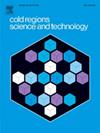Research on controlling measures of snowdrifts around Arctic ground-based buildings through shape optimization
IF 3.8
2区 工程技术
Q1 ENGINEERING, CIVIL
引用次数: 0
Abstract
Elevated structures in the Arctic region have proven effective in mitigating surrounding snowdrifts by enhancing the airflow beneath, and serve as a preferred architectural form. However, ground-based buildings still occupy the dominant position due to the constraints posed by construction costs and foundation conditions. One of the effective measures to reduce and prevent snowdrifts around such buildings is to modify their aerodynamic shapes. Therefore, this research endeavors to explore measures for controlling snowdrifts around ground-based buildings through shape optimization. Initially, the predictive accuracy of a refined Mixture model for simulating snowdrifts around ground-based structures was checked against wind tunnel test results. Based on the validated numerical model and representative Arctic meteorological conditions, the snowdrift controlling effects by changing the overall and local building shapes were investigated separately. Overall, the snow reduction and prevention effects can be effectively achieved for ground-based buildings with smoother sidewalls, such as those featuring a circular plane. Conversely, for traditional rectangular ground-based buildings, a larger downwind aspect ratio and a more inclined windward surface can significantly diminish peak snow depth. Additionally, the measures by adding windward side chamfering can effectively manage the locations of snow erosion areas, thereby enabling flexible placement of entrances and exits.
求助全文
约1分钟内获得全文
求助全文
来源期刊

Cold Regions Science and Technology
工程技术-地球科学综合
CiteScore
7.40
自引率
12.20%
发文量
209
审稿时长
4.9 months
期刊介绍:
Cold Regions Science and Technology is an international journal dealing with the science and technical problems of cold environments in both the polar regions and more temperate locations. It includes fundamental aspects of cryospheric sciences which have applications for cold regions problems as well as engineering topics which relate to the cryosphere.
Emphasis is given to applied science with broad coverage of the physical and mechanical aspects of ice (including glaciers and sea ice), snow and snow avalanches, ice-water systems, ice-bonded soils and permafrost.
Relevant aspects of Earth science, materials science, offshore and river ice engineering are also of primary interest. These include icing of ships and structures as well as trafficability in cold environments. Technological advances for cold regions in research, development, and engineering practice are relevant to the journal. Theoretical papers must include a detailed discussion of the potential application of the theory to address cold regions problems. The journal serves a wide range of specialists, providing a medium for interdisciplinary communication and a convenient source of reference.
 求助内容:
求助内容: 应助结果提醒方式:
应助结果提醒方式:


